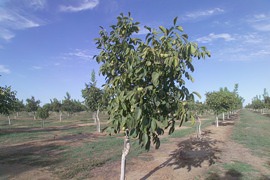Each year, many experimental trials are conducted on university campuses and labs, at research field stations, and in growers’ orchards.
This work is conducted by campus-based university and USDA scientists, UC Cooperative Extension specialists and farm advisors, graduate students, post-docs, and a myriad of student and staff helpers. Some of these efforts are long-term in nature, like the breeding and testing of new walnut varieties or rootstocks; some are shorter-term, like finding or refining the use of new tools for managing pests and diseases, or discovering new ways to make more efficient use of water and fertilizers. All of this work gets done through a unique and effective partnership between the walnut industry and the research community which engages growers, handlers, the ag service sector, researchers, extension specialists and advisors in the common goals of sustained productivity, environmental protection, and a healthy food supply. Through its industry assessments, the California Walnut Board each year funds a broad array of research efforts on genetic improvement, orchard management, and pest and disease management in walnuts. These funds leverage large public sector investments in ag research at the state and national levels.

All the research activity in the world, however well-executed and successful, matters little unless and until the results of that work are communicated to-and ultimately used by-growers and other industry participants. The need for extending the findings and benefits of public sector agricultural research and innovation to farmers was recognized early in the US. The Morrill Act, signed by President Lincoln in 1862, followed by the Hatch Act of 1887, established the US’s current system of land grant colleges and universities and charged them with conducting agricultural research to benefit the country’s growing ag sector. In time, it became apparent that this new Agricultural Experiment Station system was indeed very productive but lacked ways to effectively transmit and promote new ideas and practices to farmers who could use them. The Smith-Lever Act, passed in 1914, established the Cooperative Extension Service to help bridge this gap.
Cooperative Extension marked its 100th birthday in California last year, and continues as the pre-eminent outreach vehicle for new information and ideas developed through research. Through print and electronic media publications, meetings, telephone, text, and on-farm contacts, UC farm advisors and specialists, along with their research colleagues, work hard to extend the benefits of ongoing research to growers, handlers, and ag support industry partners. Today’s CE farm advisors also conduct a lot of research of their own in addition to collaborating with campus-based scientists on their projects. These activities increase advisors’ first-hand knowledge of field problems and their solutions, greatly enhancing the relevance and impact of their educational efforts.

Increasingly, other entities are also taking part in this information transfer. Over the past couple of decades, agricultural pest control advisors and ag production consultants have become important and effective partners in CE’s extension of research-based information to growers. Farm & equipment shows, through hosted seminars and workshops, now provide additional outlets for new ideas. Most recently, ag service & supply companies have begun hosting grower educational meetings that play a role as well. While Cooperative Extension may no longer be the “only game in town” when it comes to ag information outreach, it remains committed to its core mission of extending the benefits of ag research beyond the walls of the university and government research institutions. And it is fulfilling this mission in new and creative ways. Partnering with other entities to fulfill this mission is a natural and welcomed new development.
What does the future hold for the “research-extension continuum”? Only time will tell. Publically funded components of the system will continue to be challenged by competing societal demands for government services. Private sector support and participation will likely play an increasing role in ensuring that research continues and its benefits reach those who can benefit from it.

